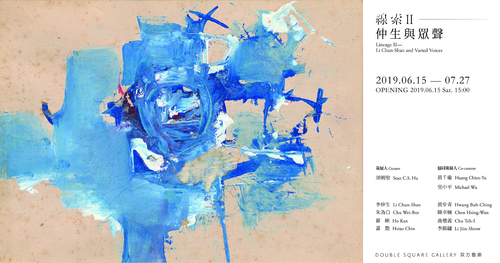Lineage II- Li Chun-Shan and Varied Voices
6/15 (Sat) - 7/27/2019 (Sat)
Li Chun-Shan, Chu Wei-Bor, Ho Kan, Hsiao Chin, Hwang Buh-Ching, Chen Hsing-Wan, Chu The-I, Li Jiin-Shiow

Exhibition dates:2019.06.15-2019.07.27
Exhibition venue: Double Square Gallery
Opening reception: 2019.06.15 (Sat.) 15.00
Artist Talk:2019.06.29 (Sat.) 15.00-16.30
Double Square Gallery is pleased to present Lineage II – Li Chun Shan and Varied Voices from June 15 to July 27, 2019. Continuing the survey and curatorial principle of the 2016 Lineage exhibition and driven by our research and passion for Taiwan’s post-war modern and contemporary art, the Gallery revisits the art of Li Chun-Shan, the pioneer of Chinese abstract painting and mentor for Taiwanese modern artists, and explores the master’s as well as his students’ influence on the development of Taiwanese art history. Curated by Sean C. S. HU, the exhibition showcases the works of Li Chun-Shan (1912-1984) and those of the master’s seven students from various periods, including Chu Wei-Bor (1929-2018), Ho Kan (b. 1932) and Hsiao Chin (b. 1935) from Ton Fan Art Group, and Hwang Buh-Ching (b. 1948), Chen Hsing-Wan (1951-2004), Chu Teh-I (b. 1952) and Li Jiin-Shiow (1953-2003) taught by Li in Changhua, showing the vibrant art scene of Taiwan’s contemporary painting spanning nearly seventy years. The exhibition especially highlights the creative careers of individual artists and epitomizes different stages of their artistic journey with selected artworks by focusing on the following stages in the artists’ careers: the guidance of Li Chun-Shan, the critical period of establishing their respective style, and their recent/latest creation. This approach allows viewers to perceive these artists’ respective evolution in concept, use of media and creative techniques, showing how each of them has matured and transformed from a self-exploring, questioning youth into an established artist that possesses his or her unique artistic language.
Li Chun-Shan was born in a scholarly family in Shaoguan, Guangdong in 1912, and had revealed his artistic talents since childhood. He enrolled in Shanghai Academy of Fine Arts in 1930, where he was immersed in the city’s culturally diverse and rich environment that expanded his mind and vision. During this time, Li also joined China’s first painting group that advocated modern art, Juelanshe (The Storm Society), hoping to break free from traditional art forms and reinvent Chinese art. During his study in Japan (1933-1937), Li actively participated in Nikakai (Nika Association), which emphasized on free thinking and artistic creation, fully demonstrating his pursuit and belief in modern art. In 1949, Li followed the Nationalist Government and moved to Taiwan. Amidst the austere, isolated social atmosphere of the time, the development of art was halted in front of a forked path of traditional ink, oil and modern painting. In order to spread the ideas of modern and avant-garde art, Li upheld a strong reformist belief and adopted a non-academic approach: using inspiring conversations in one-on-one lessons outside campus to achieve “spiritual transmission” that encouraged young artists to search within and discover their individual spirituality. From his earliest studio on Andong Street, which gave rise to the “Eight Great Outlaws” of Ton Fan Art Group, to his later travels to Changhua, where he taught students in coffee shops, Li’s endeavors nurtured numerous groups of imaginative young artists who had an unquenchable, pure thirst for art and ideals as well as a desire to communicate with their time. Li’s steadfast efforts in art education eventually grew into the undercurrents that characterized the subsequent eras. Li Chun Shan and Varied Voices starts with Li’s works inspired by the artist’s exploring of the subconscious and chronologically presents artists from different generations. From the works of Chu Wei-Bor, Ho Kan and Hsiao Chin, which represent the germination of Taiwanese abstract painting in the 50s and 60s, viewers can observe how the artists have combined elements of traditional Eastern culture, philosophy and ideology with Western avant-garde art waves to create pioneering, innovative forms that respond to their time. Since the 70s and 80s onward, Hwang Buh-Ching, Chen Hsing-Wan, Chu-Teh-I and Li Jiin-Shiow have explored beyond the boundary of two-dimensional painting, boldly experimenting with techniques and materials to create innumerous breakthroughs. Their experience of living abroad also reveals a cultural duality in their artistic life, which has led them to investigate personal experiences and focus more on visualizing their inner worlds and thinking.
Spanning several decades, Lineage II – Li Chun Shan and Varied Voices features the artists’ diversified forms of abstract painting that serve as clues to examine the development of Taiwan’s contemporary art. With our observation of and love for post-war Taiwanese contemporary art, it is hoped that the survey of the exhibition can outline the zeitgeist and atmosphere disappearing in the changing time and feature the original aspiration of the artists, who have immersed themselves in such zeitgeist and atmosphere in their fervent pursuit of art and ideals.
Sean C. S. HU was born in Taiwan in 1970. He holds an MA in Art Administration from the Fashion Institute of Technology in New York. Hu was a curator at Fubon Art Foundation. He is also a co-founder of VT Art Salon, the founder and curator of Double Square Gallery, and CEO of Hu’s Art. He has extensive curatorial experiences, among which are Nuit Blanche Taipei (2018), Spectrosynthesis - Asian LGBTQ Issues and Art Now (2017), Our Eyes (2015), Theater of Life (Seoul, Korea; 2014), SHYU Ruey Shiann: Poetic Rationality, Warm Coldness (2013), Climax: The Highlight of Ars Electronica (2005), etc.